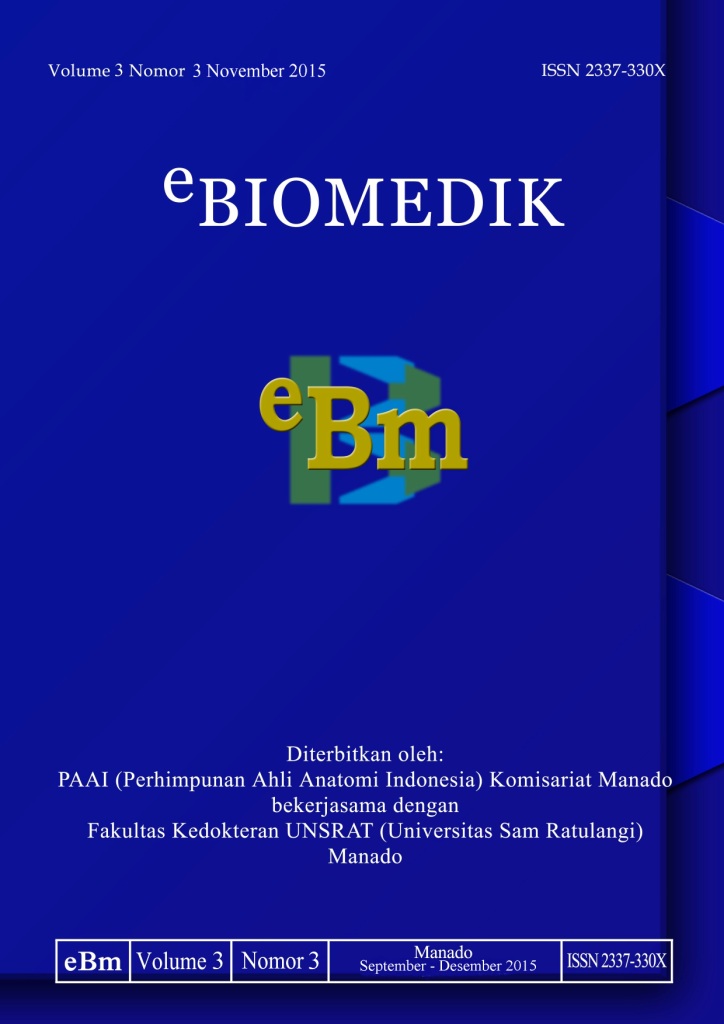GAMBARAN INDEKS MASSA TUBUH (IMT) JAMAAH MESJID AL- FATAH MALALAYANG
DOI:
https://doi.org/10.35790/ebm.v3i3.10146Abstract
Abstract: Obesity is one manifestation of nutritional problems, which need attention. Obesity is a state of excess body fat in absolute terms and relative. In 2000, the Directorate of Community Nutrition Ministry of Health recorded a total population of Indonesia are categorized as obese estimated 76.7 million (17.5%). Many factors play a role in the occurrence of obesity are largely an interaction between genetic factors and environmental factors, such as physical activity, social, economic, and nutrition. The obesity increases the risk of cardiovascular disease because its related with the metabolic syndrome or insulin resistance syndrome or / hyperinsulinemia, glucose intolerance / diabetes mellitus (DM), dyslipidemia, hypertension and other. This study uses a quantitative research design and cross-sectional approach which takes place from July to August, 2015. The total sample of 20 people were taken to the al-Fatah mosque Malalayang aged 9-21 years. The results of the research showed that respondent with weight less amounted to 8 respondent, respondents with normal weight is 10 respondents and it was the highest, respondent with pre-obesity is only one respondent, while respondent with obesity II also only 1 respondents. Conclusion: The results of this study concluded that the image of the body mass index (BMI) mosque al - Fatah Malalayang respondents with less weight have percentage of 40%, respondents with normal weight have a percentage of 45%, respondents with more weight percentage of 15%, the respondents with pre-obese weight have percentage of 5%, and the respondent with weight obesity II have a percentage of 10%.
Keywords: obesity, body mass index (BMI), diabetes mellitus (DM).
Abstrak: Obesitas merupakan salah satu manifestasi dari masalah gizi lebih, yang perlu mendapatkan perhatian. Pada tahun 2000, Direktorat Bina Gizi Masyarakat Departemen Kesehatan RI mencatat jumlah penduduk Indonesia yang masuk kategori obesitas diperkirakan 76.7 juta (17.5%) . Banyak faktor yang berperan dalam terjadinya obesitas yang sebagian besar merupakan interaksi antara faktor genetik dengan faktor lingkungan, antara lain aktivitas fisik, sosial ekonomi, dan nutrisi. Keadaan obesitas meningkatkan risiko penyakit-penyakit kardiovaskular karena keterkaitanya dengan sindrom metabolik atau atau sindrom resistensi insulin/hiperinsulinemia, intoleransi glukosa/Diabetes Melitus (DM), dyslipidemia, hipertensi dan lainnya. Penelitian ini menggunakan desain penelitian kuantitatif dan pendekatan cross sectional yang berlangsung dari Juli – Agustus 2015. total sampel berjumlah 20 orang yang diambil pada jamaah Masjid Al- Fatah Malalayang yang berusia 19 – 21 tahun. Berdasarkan hasil penelitian didapatkan bahwa responden yang memiki berat badan kurang berjumlah 8 responden, responden dengan berat badan normal 9 responden dan merupakan yang terbanyak, responden dengan pra obesitas 1 responden, sedangkan responden dengan badan obesitas II 2 responden. Simpulan: Dari hasil penelitian dapat disimpulkan bahwa gambaran Indeks Massa tubuh (IMT) masjid al – fatah malalayang responden dengan berat badan kurang memiliki persentase sebesar 40%, responden dengan berat badan normal memiliki persentase sebesar 45%, responden dengan berat badan lebih memiliki persentase sebesar 15%, responden dengan berat badan pra obesitas memiliki persentase sebesar 5%, Responden dengan berat badan obesitas II memiliki persentase sebesar 10%.
Kata kunci: obesitas, indeks massa tubuh (IMT), diabetes mellitus (DM).





